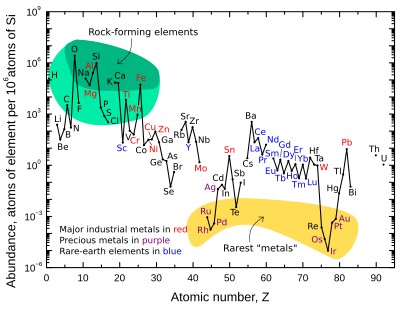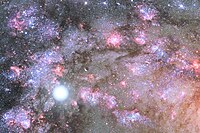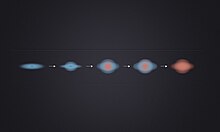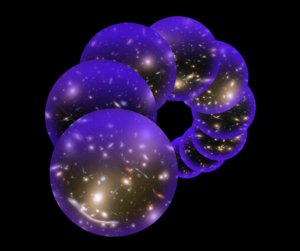In geochemistry, geophysics and nuclear physics, primordial nuclides, also known as primordial isotopes, are nuclides found on Earth that have existed in their current form since before Earth was formed. Primordial nuclides were present in the interstellar medium from which the solar system was formed, and were formed in, or after, the Big Bang, by nucleosynthesis in stars and supernovae followed by mass ejection, by cosmic ray spallation, and potentially from other processes. They are the stable nuclides plus the long-lived fraction of radionuclides surviving in the primordial solar nebula through planet accretion until the present. Only 286 such nuclides are known.
Stability
All of the known 252 stable nuclides, plus another 34 nuclides that have half-lives
long enough to have survived from the formation of the Earth, occur as
primordial nuclides. These 34 primordial radionuclides represent isotopes of 28 separate elements.
Cadmium, tellurium, xenon, neodymium, samarium and uranium each have two primordial radioisotopes (113
Cd
, 116
Cd
; 128
Te
, 130
Te
; 124
Xe
, 136
Xe
; 144
Nd
, 150
Nd
; 147
Sm
, 148
Sm
; and 235
U
, 238
U
).
Because the age of the Earth is 4.58×109 years (4.6 billion years), the half-life of the given nuclides must be greater than about 108 years (100 million years) for practical considerations. For example, for a nuclide with half-life 6×107 years (60 million years), this means 77 half-lives have elapsed, meaning that for each mole (6.02×1023 atoms) of that nuclide being present at the formation of Earth, only 4 atoms remain today.
The four shortest-lived primordial nuclides (i.e. nuclides with shortest half-lives) to have been indisputably experimentally verified are 232
Th
(1.4 x 1010 years), 238
U
(4.5 x 109 years), 40
K
(1.25 x 109 years), and 235
U
(7.0 x 108 years).
These are the 4 nuclides with half-lives comparable to, or somewhat less than, the estimated age of the universe. (232Th has a half life slightly longer than the age of the universe.) For a complete list of the 34 known primordial radionuclides, including the next 30 with half-lives much longer than the age of the universe, see the complete list below. For practical purposes, nuclides with half-lives much longer than the age of the universe may be treated as if they were stable. 232Th and 238U have half-lives long enough that their decay is limited over geological time scales; 40K and 235U have shorter half-lives and are hence severely depleted, but are still long-lived enough to persist significantly in nature.
The next longest-living nuclide after the end of the list given in the table is 244
Pu
, with a half-life of 8.08×107 years. It has been reported to exist in nature as a primordial nuclide, although a later study did not detect it. Likewise, the second-longest-lived isotope not empirically identified as primordial is 146
Sm
, which has a half-life of 6.8×107 years, about double that of the third-longest-lived such isotope 92
Nb
(3.5×107 years). Taking into account that all these nuclides must exist for at least 4.6×109 years, 244Pu must survive 57 half-lives (and hence be reduced by a factor of 257 ≈ 1.4×1017), 146Sm must survive 67 (and be reduced by 267 ≈ 1.5×1020), and 92Nb must survive 130 (and be reduced by 2130 ≈ 1.4×1039). Mathematically, considering the likely initial abundances of these nuclides, 244Pu and 146Sm
should persist somewhere within the Earth today, even if they are not
identifiable in the relatively minor portion of the Earth's crust
available to human assays, while they should not for 92Nb and all shorter-lived nuclides. Nuclides such as 92Nb that were present in the primordial solar nebula but have long since decayed away completely are termed extinct radionuclides if they have no other means of being regenerated.
Because primordial chemical elements often consist of more than one primordial isotope, there are only 83 distinct primordial chemical elements. Of these, 80 have at least one observationally stable isotope and three additional primordial elements have only radioactive isotopes (bismuth, thorium, and uranium).
Naturally occurring nuclides that are not primordial
Some unstable isotopes which occur naturally (such as 14
C
, 3
H
, and 239
Pu
) are not primordial, as they must be constantly regenerated. This occurs by cosmic radiation (in the case of cosmogenic nuclides such as 14
C
and 3
H
), or (rarely) by such processes as geonuclear transmutation (neutron capture of uranium in the case of 237
Np
and 239
Pu
). Other examples of common naturally occurring but non-primordial nuclides are isotopes of radon, polonium, and radium, which are all radiogenic nuclide
daughters of uranium decay and are found in uranium ores. A similar
radiogenic series is derived from the long-lived radioactive primordial
nuclide 232Th. These nuclides are described as geogenic, meaning that they are decay or fission products of uranium or other actinides in subsurface rocks.
All such nuclides have shorter half-lives than their parent radioactive
primordial nuclides. Some other geogenic nuclides do not occur in the decay chains of 232Th, 235U, or 238U but can still fleetingly occur naturally as products of the spontaneous fission of one of these three long-lived nuclides, such as 126Sn, which makes up about 10−14 of all natural tin.
Primordial elements
There are 252 stable primordial nuclides and 34 radioactive primordial nuclides, but only 80 primordial stable elements (1 through 82, i.e. hydrogen through lead, exclusive of 43 and 61, technetium and promethium respectively) and three radioactive primordial elements (bismuth, thorium, and uranium).
Bismuth's half-life is so long that it is often classed with the 80 primordial stable elements instead, since its radioactivity is not a cause for serious concern. The number of elements is fewer than the number of nuclides, because many of the primordial elements are represented by multiple isotopes.
Naturally occurring stable nuclides
As noted, these number about 252. For a complete list noting which of the "stable" 252 nuclides may be in some respect unstable, see list of nuclides and stable nuclide. These questions do not impact the question of whether a nuclide is primordial, since all "nearly stable" nuclides, with half-lives longer than the age of the universe, are also primordial.
Radioactive primordial nuclides
Although it is estimated that about 34 primordial nuclides are radioactive
(list below), it becomes very difficult to determine the exact total
number of radioactive primordials, because the total number of stable
nuclides is uncertain. There exist many extremely long-lived nuclides
whose half-lives are still unknown. For example, it is predicted
theoretically that all isotopes of tungsten, including those indicated by even the most modern empirical methods to be stable, must be radioactive and can decay by alpha emission, but as of 2013 this could only be measured experimentally for 180
W
. Similarly, all four primordial isotopes of lead are expected to decay to mercury, but the predicted half-lives are so long (some exceeding 10100
years) that this can hardly be observed in the near future.
Nevertheless, the number of nuclides with half-lives so long that they
cannot be measured with present instruments—and are considered from this
viewpoint to be stable nuclides—is limited. Even when a "stable" nuclide is found to be radioactive, it merely moves from the stable to the unstable list of primordial nuclides, and the total number of primordial nuclides remains unchanged.
List of 34 radioactive primordial nuclides and measured half-lives
These 34 primordial nuclides represent radioisotopes of 28 distinct chemical elements (cadmium, neodymium, samarium, tellurium, uranium, and xenon each have two primordial radioisotopes). The radionuclides are listed in order of stability, with the longest half-life beginning the list. These radionuclides in many cases are so nearly stable that they compete for abundance with stable isotopes of their respective elements. For three chemical elements, indium, tellurium, and rhenium, a very long-lived radioactive primordial nuclide is found in greater abundance than a stable nuclide.
The longest-lived radionuclide has a half-life of 2.2×1024 years, which is 160 trillion times the age of the Universe. Only four of these 34 nuclides have half-lives shorter than, or equal to, the age of the universe. Most of the remaining 30 have half-lives much longer. The shortest-lived primordial isotope, 235U, has a half-life of 704 million years, about one sixth of the age of the Earth and the Solar System.
| No. | Nuclide | Energy | Half- life (years) |
Decay mode |
Decay energy (MeV) |
Approx. ratio half-life to age of universe |
|---|---|---|---|---|---|---|
| 253 | 128Te | 8.743261 | 2.2×1024 | 2 β− | 2.530 | 160 trillion |
| 254 | 124Xe | 8.778264 | 1.8×1022 | KK | 2.864 | 1 trillion |
| 255 | 78Kr | 9.022349 | 9.2×1021 | KK | 2.846 | 670 billion |
| 256 | 136Xe | 8.706805 | 2.165×1021 | 2 β− | 2.462 | 150 billion |
| 257 | 76Ge | 9.034656 | 1.8×1021 | 2 β− | 2.039 | 130 billion |
| 258 | 130Ba | 8.742574 | 1.2×1021 | KK | 2.620 | 90 billion |
| 259 | 82Se | 9.017596 | 1.1×1020 | 2 β− | 2.995 | 8 billion |
| 260 | 116Cd | 8.836146 | 3.102×1019 | 2 β− | 2.809 | 2 billion |
| 261 | 48Ca | 8.992452 | 2.301×1019 | 2 β− | 4.274, .0058 | 2 billion |
| 262 | 96Zr | 8.961359 | 2.0×1019 | 2 β− | 3.4 | 1 billion |
| 263 | 209Bi | 8.158689 | 1.9×1019 | α | 3.137 | 1 billion |
| 264 | 130Te | 8.766578 | 8.806×1018 | 2 β− | .868 | 600 million |
| 265 | 150Nd | 8.562594 | 7.905×1018 | 2 β− | 3.367 | 600 million |
| 266 | 100Mo | 8.933167 | 7.804×1018 | 2 β− | 3.035 | 600 million |
| 267 | 151Eu | 8.565759 | 5.004×1018 | α | 1.9644 | 300 million |
| 268 | 180W | 8.347127 | 1.801×1018 | α | 2.509 | 100 million |
| 269 | 50V | 9.055759 | 1.4×1017 | β+ or β− | 2.205, 1.038 | 10 million |
| 270 | 113Cd | 8.859372 | 7.7×1015 | β− | .321 | 600,000 |
| 271 | 148Sm | 8.607423 | 7.005×1015 | α | 1.986 | 500,000 |
| 272 | 144Nd | 8.652947 | 2.292×1015 | α | 1.905 | 200,000 |
| 273 | 186Os | 8.302508 | 2.002×1015 | α | 2.823 | 100,000 |
| 274 | 174Hf | 8.392287 | 2.002×1015 | α | 2.497 | 100,000 |
| 275 | 115In | 8.849910 | 4.4×1014 | β− | .499 | 30,000 |
| 276 | 152Gd | 8.562868 | 1.1×1014 | α | 2.203 | 8000 |
| 277 | 190Pt | 8.267764 | 6.5×1011 | α | 3.252 | 47 |
| 278 | 147Sm | 8.610593 | 1.061×1011 | α | 2.310 | 7.7 |
| 279 | 138La | 8.698320 | 1.021×1011 | K or β− | 1.737, 1.044 | 7.4 |
| 280 | 87Rb | 9.043718 | 4.972×1010 | β− | .283 | 3.6 |
| 281 | 187Re | 8.291732 | 4.122×1010 | β− | .0026 | 3 |
| 282 | 176Lu | 8.374665 | 3.764×1010 | β− | 1.193 | 2.7 |
| 283 | 232Th | 7.918533 | 1.406×1010 | α or SF | 4.083 | 1 |
| 284 | 238U | 7.872551 | 4.471×109 | α or SF or 2 β− | 4.270 | 0.3 |
| 285 | 40K | 8.909707 | 1.25×109 | β− or K or β+ | 1.311, 1.505, 1.505 | 0.09 |
| 286 | 235U | 7.897198 | 7.04×108 | α or SF | 4.679 | 0.05 |
List legends
- No. (number)
- A running positive integer for reference. These numbers may change slightly in the future since there are 162 nuclides now classified as stable, but which are theoretically predicted to be unstable, so that future experiments may show that some are in fact unstable. The number starts at 253, to follow the 252 (observationally) stable nuclides.
- Nuclide
- Nuclide identifiers are given by their mass number A and the symbol for the corresponding chemical element (implies a unique proton number).
- Energy
- Mass of the average nucleon of this nuclide relative to the mass of a neutron (so all nuclides get a positive value) in MeV/c2, formally: mn − mnuclide / A.
- Half-life
- All times are given in years.
- Decay mode
α α decay β− β− decay K electron capture KK double electron capture β+ β+ decay SF spontaneous fission 2 β− double β− decay 2 β+ double β+ decay I isomeric transition p proton emission n neutron emission - Decay energy
- Multiple values for (maximal) decay energy in MeV are mapped to decay modes in their order.














